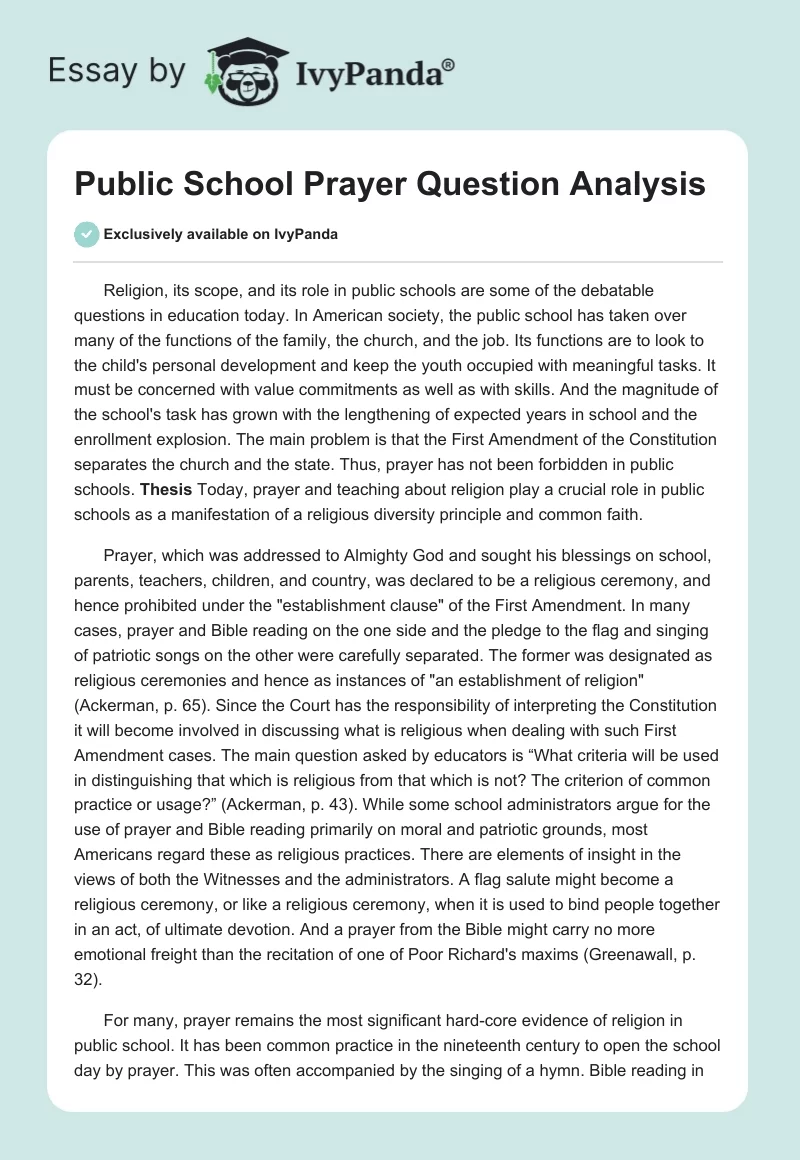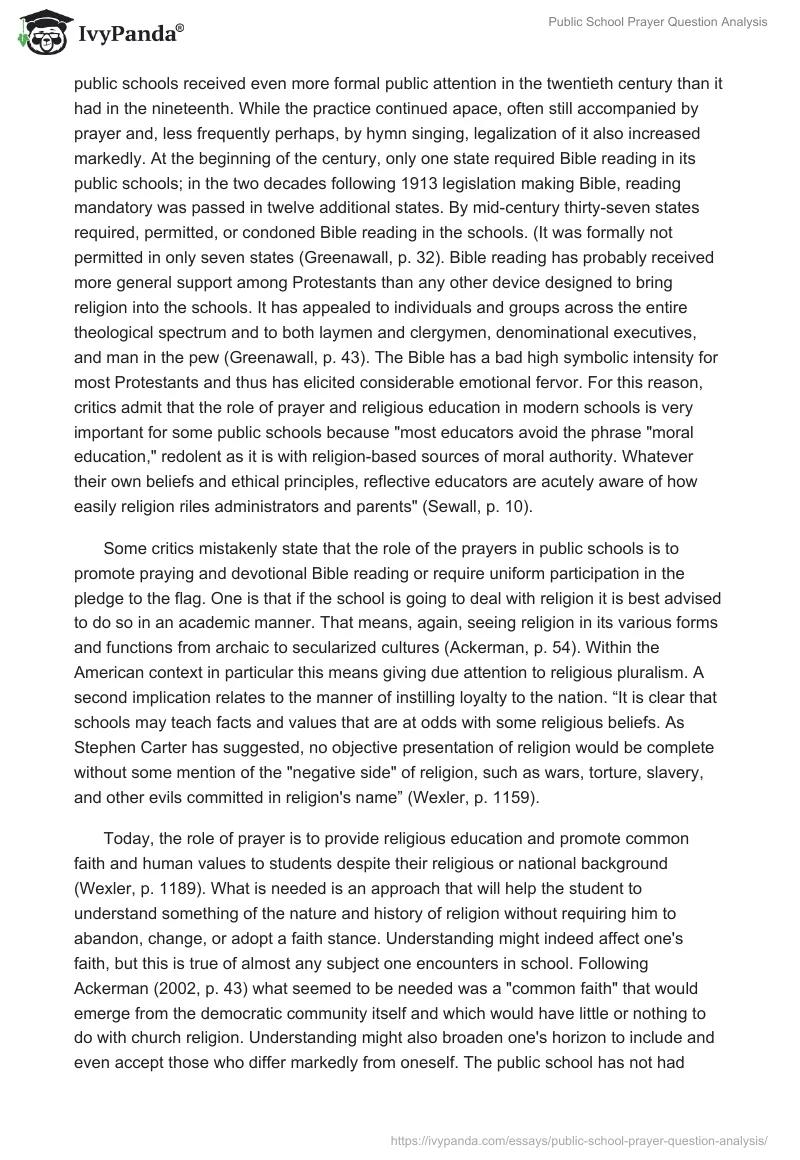Religion, its scope, and its role in public schools are some of the debatable questions in education today. In American society, the public school has taken over many of the functions of the family, the church, and the job. Its functions are to look to the child’s personal development and keep the youth occupied with meaningful tasks. It must be concerned with value commitments as well as with skills. And the magnitude of the school’s task has grown with the lengthening of expected years in school and the enrollment explosion. The main problem is that the First Amendment of the Constitution separates the church and the state. Thus, prayer has not been forbidden in public schools. Thesis Today, prayer and teaching about religion play a crucial role in public schools as a manifestation of a religious diversity principle and common faith.
Prayer, which was addressed to Almighty God and sought his blessings on school, parents, teachers, children, and country, was declared to be a religious ceremony, and hence prohibited under the “establishment clause” of the First Amendment. In many cases, prayer and Bible reading on the one side and the pledge to the flag and singing of patriotic songs on the other were carefully separated. The former was designated as religious ceremonies and hence as instances of “an establishment of religion” (Ackerman, p. 65). Since the Court has the responsibility of interpreting the Constitution it will become involved in discussing what is religious when dealing with such First Amendment cases. The main question asked by educators is “What criteria will be used in distinguishing that which is religious from that which is not? The criterion of common practice or usage?” (Ackerman, p. 43). While some school administrators argue for the use of prayer and Bible reading primarily on moral and patriotic grounds, most Americans regard these as religious practices. There are elements of insight in the views of both the Witnesses and the administrators. A flag salute might become a religious ceremony, or like a religious ceremony, when it is used to bind people together in an act, of ultimate devotion. And a prayer from the Bible might carry no more emotional freight than the recitation of one of Poor Richard’s maxims (Greenawall, p. 32).
For many, prayer remains the most significant hard-core evidence of religion in public school. It has been common practice in the nineteenth century to open the school day by prayer. This was often accompanied by the singing of a hymn. Bible reading in public schools received even more formal public attention in the twentieth century than it had in the nineteenth. While the practice continued apace, often still accompanied by prayer and, less frequently perhaps, by hymn singing, legalization of it also increased markedly. At the beginning of the century, only one state required Bible reading in its public schools; in the two decades following 1913 legislation making Bible, reading mandatory was passed in twelve additional states. By mid-century thirty-seven states required, permitted, or condoned Bible reading in the schools. (It was formally not permitted in only seven states (Greenawall, p. 32). Bible reading has probably received more general support among Protestants than any other device designed to bring religion into the schools. It has appealed to individuals and groups across the entire theological spectrum and to both laymen and clergymen, denominational executives, and man in the pew (Greenawall, p. 43). The Bible has a bad high symbolic intensity for most Protestants and thus has elicited considerable emotional fervor. For this reason, critics admit that the role of prayer and religious education in modern schools is very important for some public schools because “most educators avoid the phrase “moral education,” redolent as it is with religion-based sources of moral authority. Whatever their own beliefs and ethical principles, reflective educators are acutely aware of how easily religion riles administrators and parents” (Sewall, p. 10).
Some critics mistakenly state that the role of the prayers in public schools is to promote praying and devotional Bible reading or require uniform participation in the pledge to the flag. One is that if the school is going to deal with religion it is best advised to do so in an academic manner. That means, again, seeing religion in its various forms and functions from archaic to secularized cultures (Ackerman, p. 54). Within the American context in particular this means giving due attention to religious pluralism. A second implication relates to the manner of instilling loyalty to the nation. “It is clear that schools may teach facts and values that are at odds with some religious beliefs. As Stephen Carter has suggested, no objective presentation of religion would be complete without some mention of the “negative side” of religion, such as wars, torture, slavery, and other evils committed in religion’s name” (Wexler, p. 1159).
Today, the role of prayer is to provide religious education and promote common faith and human values to students despite their religious or national background (Wexler, p. 1189). What is needed is an approach that will help the student to understand something of the nature and history of religion without requiring him to abandon, change, or adopt a faith stance. Understanding might indeed affect one’s faith, but this is true of almost any subject one encounters in school. Following Ackerman (2002, p. 43) what seemed to be needed was a “common faith” that would emerge from the democratic community itself and which would have little or nothing to do with church religion. Understanding might also broaden one’s horizon to include and even accept those who differ markedly from oneself. The public school has not had much experience in dealing with religious differences in a controlled classroom atmosphere conducive to learning. There are some indications, however, that such an approach can achieve positive results in increasing the desire to know and in raising the level of understanding (Greenawall, pp. 35-36).
The school prayer offers the student an almost infinite number of possibilities for exploration. There are two criteria for selecting which aspects of the subject to study. The more obvious relates to questions of influence and importance in one’s own cultural and personal experience. Hence the study of the Bible is more important for most Americans. The other criterion has to do with the fact that while man’s religious experience evidences great variety there are also common elements in it. Hence one might profitably investigate similar phenomena from various cultural settings. For example, the study of the Bible and the Qur’an side by side or in tandem might elicit insights not easily gained by studying either by itself. Both criteria are relevant to public school efforts in the study of religion (Greenawall, p. 72). The school can and should give more attention than it has to the religious aspects of the American experience, for example. It may also assist students in achieving a further realization of both the commonality and the diversity of human experience by comparing aspects of the American experience with similar phenomena in other cultures.
Critics and educators agree that religious education is important for students because it promotes human values, cultural traditions, and behavior patterns. Thus, aside from the problem of finding or producing skilled and knowledgeable teachers of religion, real difficulties are stemming from the communal context of the school itself. Furthermore, the history of a subject leads educators to conclude that they have reached a point where, as a result of continuing secularization and the growing acknowledgment of the realities of pluralism, prayers are better prepared for this kind of approach. The public school today is in deep trouble because of its past inadequacies and increasing social turmoil (Smolla, p. 113). Disaffected citizens, especially blacks, reacting in part to the grossly inadequate public school system they have known, forcefully proclaim a new declaration of independence, affirming their right and intention to assume control over their own and their children’s formal education. Critics assert that the public school system has become so overly standardized that it has gone stale. “Educators and policy makers have agreed that public schools can and should strengthen classroom teaching about religion and its function in human affairs. Several national organizations have constructed action plans and programmatic guides” (Smolla, p. 113).
Moments of silence are practiced in some public schools to give time for religious students to pray. The Court struck down a statute about Moments of silence. Many critics suppose that moments of silence propagate religion at schools and should be prohibited. There is a thin line that divides nationalism from religion, a patriotic rite from a religious one. The Court understandably sought to widen that line into a marked boundary. It would appear that the Court has not made this task easier by its open-ended understanding of religion. Patriotic exercises in the school ought not to be carried on in such a high-pressured way as to compel all to participate regardless of personal conscience or to force the acceptance of a particular point of view (Greenawall, p. 58). Some schools propose to start a day with prayer during moments of silence. This policy promotes religious diversity and accepts the religious rights of all students. “In many schools, most of the parents and teachers alike must have begun their own school days by saying prayers or reading the Bible. The moment-of-silence laws cannot be evaluated without taking into account this cultural fact that will unavoidably give a religious coloring to an ostensibly neutral law” (Drakeman n.d.).
In sum, prayer still plays an important role in public schools as a part of religious and cultural diversity. Now it appears that the role of religion is sharply reduced. For many students, prayer and Bible teaching are formal procedures established by a school. Any attempt to reduce the role and importance of prayer is not likely to succeed at public schools. While religious rituals, such as the devotional utterance of the Lord’s prayer, might be discontinued in regular school practice, religious issues cannot be eliminated. If this is indeed the case then what is needed is as intelligent an approach as possible to these issues. it is important to admit that the major American traditions of church religion seldom achieved a united front in their approach to public schools. Their fundamental relationship remained one of competition and conflict.
Works Cited
- Ackerman, D.M. Prayer and Religion in the Public Schools. Nova Science Publishers, 2002.
- Drakeman, D.L. Religion’s Place in Public Schools. N.d.
- Greenawall, K. Does God Belong in Public Schools? Princeton University Press, 2004.
- Sewall, G.T. Religion Comes to School. Phi Delta Kappan 81, 1999, p. 10.
- Smolla, R.A. The Constitutionality of Mandatory Public School Community Service Programs. Law and Contemporary Problems 62, 1999, p. 113.
- Wexler, J.D. Preparing for the Clothed Public Square: Teaching about Religion, Civic Education, and the Constitution. William and Mary Law Review 43, 2002, p. 1159.


